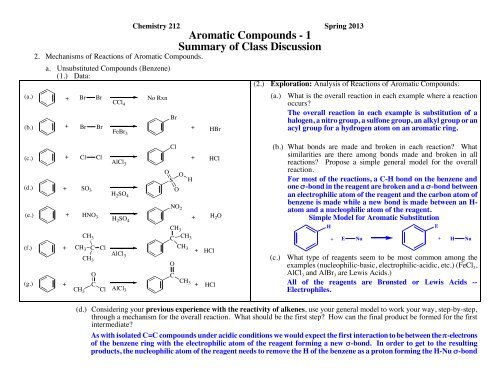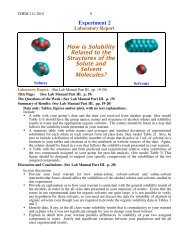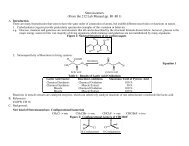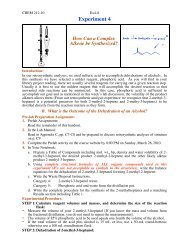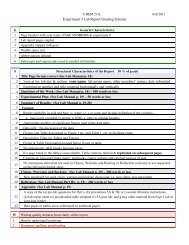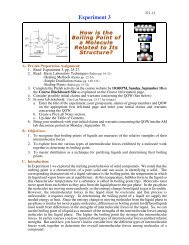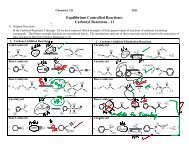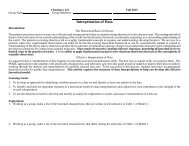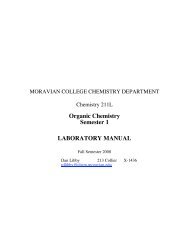Aromatic Compounds - 1 Summary of Class Discussion
Aromatic Compounds - 1 Summary of Class Discussion
Aromatic Compounds - 1 Summary of Class Discussion
Create successful ePaper yourself
Turn your PDF publications into a flip-book with our unique Google optimized e-Paper software.
(a.)(b.)(c.)(d.)(e.)Chemistry 212 Spring 2013<strong>Aromatic</strong> <strong>Compounds</strong> - 1<strong>Summary</strong> <strong>of</strong> <strong>Class</strong> <strong>Discussion</strong>2. Mechanisms <strong>of</strong> Reactions <strong>of</strong> <strong>Aromatic</strong> <strong>Compounds</strong>.a. Unsubstituted <strong>Compounds</strong> (Benzene)(1.) Data:+++++BrBrCCl 4BrClBrClFeBr 3AlCl 3SO 3H 2 SO 4H 2 SO 4No RxnOSBrClONO 2O H+++HBrHClH 2 O(2.) Exploration: Analysis <strong>of</strong> Reactions <strong>of</strong> <strong>Aromatic</strong> <strong>Compounds</strong>:(a.) What is the overall reaction in each example where a reactionoccurs?The overall reaction in each example is substitution <strong>of</strong> ahalogen, a nitro group, a sulfone group, an alkyl group or anacyl group for a hydrogen atom on an aromatic ring.(b.) What bonds are made and broken in each reaction? Whatsimilarities are there among bonds made and broken in allreactions? Propose a simple general model for the overallreaction.For most <strong>of</strong> the reactions, a C-H bond on the benzene andone σ-bond in the reagent are broken and a σ-bond betweenan electrophilic atom <strong>of</strong> the reagent and the carbon atom <strong>of</strong>benzene is made while a new bond is made between an H-atom and a nucleophilic atom <strong>of</strong> the reagent.Simple Model for <strong>Aromatic</strong> SubstitutionHE(f.)(g.)++CH 3CH 3C CH 3CH 3 C ClCH 3AlClCH 33OOCCHC3CH 3 Cl AlCl 3++HClHCl+ E Nu(c.) What type <strong>of</strong> reagents seem to be most common among theexamples (nucleophilic-basic, electrophilic-acidic, etc.) (FeCl 3 ,AlCl 3 and AlBr 3 are Lewis Acids.)All <strong>of</strong> the reagents are Brønsted or Lewis Acids --Electrophiles.+HNu(d.) Considering your previous experience with the reactivity <strong>of</strong> alkenes, use your general model to work your way, step-by-step,through a mechanism for the overall reaction. What should be the first step? How can the final product be formed for the firstintermediate?As with isolated C=C compounds under acidic conditions we would expect the first interaction to be between the π-electrons<strong>of</strong> the benzene ring with the electrophilic atom <strong>of</strong> the reagent forming a new σ-bond. In order to get to the resultingproducts, the nucleophilic atom <strong>of</strong> the reagent needs to remove the H <strong>of</strong> the benzene as a proton forming the H-Nu σ-bond
2 <strong>Aromatic</strong> <strong>Compounds</strong>and reforming the aromatic system <strong>of</strong> the ring. This second step is essentially the second step <strong>of</strong> the E 1 eliminationmechanism. So both steps have precedents in our recent experience.HHE+ E NuE +Nu+HNu(e.) Apply your general mechanism to each <strong>of</strong> the reactions in the data set. (NOTE: as indicated above, FeCl 3 , AlCl 3 and AlBr 3 areLewis Acids. As illustrated below, their positively charged metal ions associate with the lone pair e - ‘s on one <strong>of</strong> the halogen oroxygen atoms in the reagent. The nuclear charge <strong>of</strong> the metal ion lowers the energy <strong>of</strong> the e - 's <strong>of</strong> that halogen or oxygen atom. Asshown below for reactions (e.) -> (g.) the reagents combine to form an electrophilic intermediate that reacts with the aromatic ring.Reactions b & c – Illustrated for the reaction <strong>of</strong> Br 2 .H+!BrBr!FeBr 3Br+FeBr 4HBr+HBrThe electrophile is a complex <strong>of</strong> the halogen with Ferric halide complex that polarizes the halogen electrons toward the iron.Initial reaction <strong>of</strong> the electrophile with the benzene π electrons produces a delocalized cation on the ring. The nucleophileproduced is the ferric tetra-halide anion complex that releases the hydrogen halide upon protonation.
<strong>Aromatic</strong> <strong>Compounds</strong> 3Reactions dOH+OOSOHOSOOHOS OOH+HOOSOOHSOOHO + H 2 SO 4In this case SO 3 acts as the electrophile and H 2 SO 4 serves as an acid and base catalyst after the first step. (See CGW pp 476-478) In this case the bond broken in the electrophile is a π-bond so the reagent remains a single unit and regains the protonremoved from the ring. So technically, the net reaction is addition, but the mechanism follows the same sequence as thesubstitution reaction and a ring C-H bond is replaced by a C-S. As we discussed in class it is also reasonable to protonateSO 3 before the reaction with the aromatic ring. (See CGW p.476)HHSOOOH+OOSOOH
4 <strong>Aromatic</strong> <strong>Compounds</strong>The following reagents react to form the actual active electrophile. These reactions are illustrated below. Complete the mechanisms using the activeelectrophile.Reaction e+ONOHOO+ HSO 4 ++HSOH 2 SO 4N4 N+ H 2 O O + H 2 OO + H 2 OHHNO 3 + H 2 SO 4As explained in the question and illustrated in the equations and on p. 476 <strong>of</strong> CGW, the mixture <strong>of</strong> HNO 3 and H 2 SO 4 reactto form the electrophile, NO 2+ , water and hydrogen sulfate anion. The after the initial electrophilic addition step, the HEEon HSO 4- remove the proton from the intermediate complex forming the nitro aromatic and reforming sulfuric acid.Reaction fFor 2˚ or 3˚ alkyl halides, the aluminum trihalide complex dissociates to form the free carbocation, which acts as theelectrophile. (See reactions b & c above). (See also CGWW p. 553)CHCH 3H3dd++ C + AlBrCH 43CH 3CHCH 333˚ cation has sufficient e - density that itcan form without a large energy increase.C Br AlBr 3HCH 3CCH 3CH 3CH 3+HBrHCCH 3CH 3AlBr 4
<strong>Aromatic</strong> <strong>Compounds</strong> 5Acyl halides (Rxn g) interact with the catalysts to form acylium ions that act as carbon electrophiles toward the aromatic ring.Reaction h.+CH 3COClAlCl 3An Acylium IonCH 3 C OH++ AlCl 4OHCHC3+ AlCl 4CH 3CO+ H-Cl(f.) What problems did you encounter in applying your general mechanism to all <strong>of</strong> the reactions? Could you modify your mechanismto work for all <strong>of</strong> the reactions? How or why not? Explain.Explanations above.(g.) Based upon your experience in (2) (a.) -> (f.), your understanding <strong>of</strong> alkene reactions, and the structure and energy <strong>of</strong> aromaticcompounds, propose a reason why it is reasonable that aromatic compounds might undergo substitution rather than addition asalkenes do. You should consider (write out) the expected mechanism for addition and compare the energies <strong>of</strong> the transitionstates for substitution vs. addition in each case.The mechanism proposed in d. above still seems to be appropriate and can account for all <strong>of</strong> the products in the data set.H+ E Nu!HENu !1 2H!E + NuHENu !E+HNuaromtic partially aromtic non-aromtic partially aromticaromticThe second step differs from that in electrophilic addition to alkenes because the partial aromaticity developing in thesubstitution (loss <strong>of</strong> the proton makes the substitution lower in energy than the addition (Br adding to the cation)which lacks aromaticity.
6 <strong>Aromatic</strong> <strong>Compounds</strong>Transition States for Substitution vs Addition to Benzene<strong>Aromatic</strong>SubstitutionHEH+NuHBrH+Nu<strong>Aromatic</strong>Addition!BrH! BrHPartially <strong>Aromatic</strong>Delocalized PartialCation!HBrH!NuDelocalized butNOT <strong>Aromatic</strong> PartialCationE+ HNuOnly Product IsolatedHEHNuNot Formed in Significant Amounts
<strong>Aromatic</strong> <strong>Compounds</strong> 7(h,) Considering your answers and mechanisms above, try to suggest a reason why there is no reaction in example (1.) (a.), whilecyclohexene (See below) reacts under identical conditions. A reaction coordinate diagram may be helpful to your analysis.+(a.) +BrBrCCl 4BrBrBr Br No RxnCCl 4+BrBrAlkene<strong>Aromatic</strong>w/o catalyst!G <strong>Aromatic</strong>w/ catalystG!G AlkenereactantsAlkene<strong>Aromatic</strong>!G <strong>Aromatic</strong>w/o catalyst<strong>Aromatic</strong>w/ catalyst<strong>Aromatic</strong>w/ catalystRxn CoordinateThere should be no reaction in example (1.) (a.) because the relatively low energy <strong>of</strong> the aromatic ring e-'s together withthe relatively high energy <strong>of</strong> the e-'s on the partially negative leaving Br atom in the transition state make the ΔG forformation <strong>of</strong> the intermediate cation too high to produce a significant rate <strong>of</strong> reaction. The catalyst decreases theenergy <strong>of</strong> the partial negative on Br in the transition state. So with the catalyst, the relatively lower energy transitionstate makes the ΔG low enough to allow the reaction to proceed.Because the π-electrons <strong>of</strong> the alkene have considerably higher energy than those in the aromatic π system, the ΔG for theaddition <strong>of</strong> halogen to the C=C is low enough to occur even without the FeBr 3 in the transition state.


